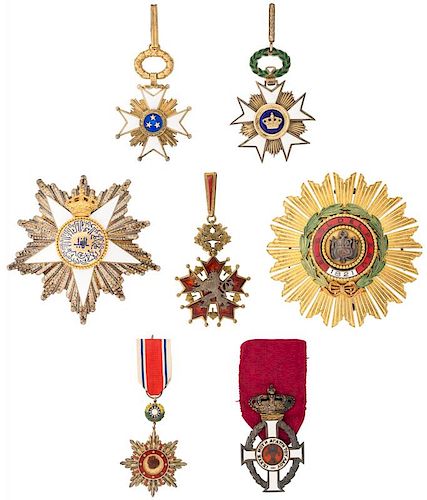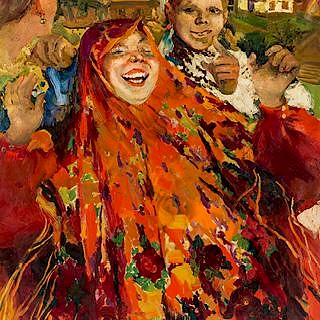A GROUP OF SEVEN MEDALS BELONGING TO VICTOR HOO
About Seller
566 East Boston Post Road
Mamaroneck, NY 10543
United States
Our auctions feature an impressive selection of fine art, decorative art, rare books, icons, militaria, and other objects from antiquity to the present. Shapiro Auctions advertises globally and has clients all over the world, while providing a rare combination of personal service and the ability to ...Read more
Two ways to bid:
- Leave a max absentee bid and the platform will bid on your behalf up to your maximum bid during the live auction.
- Bid live during the auction and your bids will be submitted real-time to the auctioneer.
Bid Increments
| Price | Bid Increment |
|---|---|
| $0 | $25 |
| $500 | $50 |
| $1,000 | $100 |
| $2,000 | $250 |
| $5,000 | $500 |
| $10,000 | $1,000 |
| $20,000 | $2,500 |
| $50,000 | $5,000 |
| $100,000 | $10,000 |
| $200,000 | $25,000 |
About Auction
Mar 7, 2018 - Mar 8, 2018
Shapiro Auctions info@shapiroauctions.com
- Lot Description
A GROUP OF SEVEN MEDALS BELONGING TO VICTOR HOO
comprising:
a) Greece: Neck Badge of Commander of the Order of George I (Third Class) c. 1920
Gilt silver and white and red enamels; the badge of white-enamelled Latin cross pattee in gold with a wreath of laurels between the arms of the cross, the obverse central disc in red enamel bearing the royal cypher of George I with two crossed gammas with a crown above and a "I" below, surrounded by a white enamel ring bearing the royal motto _____ ___ _ _____ ___ ____ (The Love of My People is My Strength). The badge topped by a crown. Plain crimson red ribbon. Rev Central disc bears the years of George I`s reign, 1863-1913 and the year 1915, when the Order was instituted. 58 x 37 mm not including ribbon, 87 x 37 mm including ribbon.
b) Belgium: Knight Cross of the Order of the Crown (Ordre de la Couronne), (Third Class)
Gilt silver and white and blue enamels; the badge of the order with a five cleft-armed star in-filled with a pentagonal pattern of intermediate rays, the blue enamel center medallion bearing an image of the royal crown on the obverse side. Rev Mirrored royal "L" monogram of King Leopold II. 45 x 58 not including wreath and sash suspension, 105 x 58 including suspension. Instituted on October 15, 1897 by King_Leopold_II.
c) Latvia: Sash Badge of the Order of Three Stars (Triju Zvaig__u ordenis), Third Class
Gilt silver and white and blue enamels; the badge of a white-enameled Latin cross pattee in gold with a wreath of laurels between the arms of the cross, the obverse central disc in blue enamel bearing three golden five-point stars. Rev Centerpiece reading Per aspera ad astra and Latvijas Republika, 1918 G. 18 NOVEMBRIS. 35 x 45 mm not including wreath and sash suspension, 192 x 45 mm including suspension. Instituted on March 24, 1924 in remembrance of the founding of Latvia.
d) Czech Republic: Grand Cross of the Order of the White Lion (_d Bleho lva). Gilt silver and red, blue and black enamels; the badge of the order with a five-point cleft-armed star in-filled with red enamel with gold leaflets between the arms, the centerpiece a silver lion of the National Coat of Arms of the Czech Republic. Rev Five cleft-armed star in-filled with red, black and blue enamel with gold leaflets between the arms, the centerpiece with five coats of arms: Bohemia, Moravia, Silesia, Slovakia and Carpathian Ruthenia, all former parts of Czechoslovakia. 60 x 60 mm not including of its linden leaves with crossed branches and sash suspension, 118 x 60 mm including suspension.
e) Egypt: Breast Star of the Commander of the Order of the Nile (Kiladat El Nil)
Gilt silver and white enamel; the badge of the order a ten-point star with mounted centerpiece in-filled with white enamel and topped by a crown. Rev Hallmark and makers mark CATTES. 77 x 80 mm, vertical pinback flanked by dual prongs. Egypt`s highest state honor. The award was instituted on April 15, 1915 by Sultan Hussein Kamel to be awarded by Egypt for exceptional services to the nation. Reconstituted under the Arab Republic of Egypt on 18 June 1953.
f) Peru: Grand Cross of the Order of the Sun of Peru (Orden El Sol del Per) (Second Class)
Gilt silver and red and white enamels; the badge of an eighteen-point cleft-armed star with red- and white-enamelled centerpiece reading EL SOL DE PERU, featuring the coat of arms surrounded by a wreath with bow. Rev Issued by Casa Nacional de Moneda, Lima-Peru, inscribed Pareja. 80 x 80 mm, missing vertical pinback flanked by dual prongs. Instituted on October 8, 1821 by General Jose de San Martn. Reconstituted in 1921.
g) Breast star of a Chinese order; badge of an eight-point star with circular red-enamelled centerpiece decorated with eight golden five-point stars. Rev Makers mark and hallmark with Archaic Chinese characters, serial number 479. 75 x 72 mm including ribbon and suspension, 165 x 72 mm not including suspension.
LOT NOTES
Lot numbers 3-17 in this auction are from the collections of the prominent historical figures Dr. Victor Chi-tsai Hoo and his brother Ambassador Hu Shi Xi, dignitaries from the Republic of China, and themselves descending from an influential family of diplomats. Their father, Hu Weide, was the Vice Minister of Foreign Affairs in the Qing Dynasty, and briefly served as the Premier of the Republic of China after Duan Qirui was ousted from Beijing in 1926. He was instrumental in bringing democracy to the Qing Dysnasty and was a member of the Chinese delegation at both the Treaty of Versailles as well as the Hague Peace Conference.
Victor Hoo, coming from such an illustrious family, continued in his father's footsteps as a diplomat for the Republic of China. Having represented China at the League of Nations, Dr. Hoo was later named Vice Minister of Foreign Affairs in 1945, and later became the highest ranking Nationalist Chinese at the United Nations, becoming Undersecretary General. The only member of the higher staff of the United Nations to speak all five official languages fluenty (Chinese, Russian, English, French, and Spanish), Dr. Hoo was socially adept and extremely active on the international stage. He was both a participant and contributor representing the Republic of China's wishes at the most seminal events of the 20th Century, including the Versailles Treaty, the San Francisco Conference creating the UN, Dumbarton Oaks, and many others. It is perhaps for this reason, that Chiang Kai Shek ordered Dr. Victor Hoo to remain at office at the United Nations as long as possible, which he did until the end of his life, at the age of 77.
PROVENANCE
Awarded to U.N. Under-Secretary General Victor Chi_tsai Hoo (1894-1972)
thence by descent in the family - Shipping Info
-
• All items must be paid for before they can be released.
• For shipments to domestic and international locations, while we do not ship directly, we can recommend some shippers who are local to us, and can pick-up your items from our office with your authorization. Clients are free to choose their own shippers, and these recommendations are provided only for your convenience. We will not accept liability for any recommendations of shippers.
• The purchaser is responsible for insuring his or her items in transit. Once items have been picked-up or released to a shipper, they are no longer covered under our insurance.
• Payment for shipment and arrangements for shipment, must be made with the shipper directly.
• Once you have made arrangement with a shipper, please email or fax us authorizing us torelease your property to that person or company.
Our primary recommended shipper is:
Fine Art Shippers Corp.
30 West 47th St.
Suite 505B
New York, NY 10036
Services Provided: Boxing, Crating, Domestic and Worldwide Delivery via Fedex, UPS, DHL, and other carriers, local van and truck deliveries in New York City, Long Island, the Tri-State Area.
Contact Information
email: info@fineartshippers.com
Telephone: +1 (917) 658-5075
Please reference the sale date and lot number(s) if you would like delivery quotes before or after purchase.
n.b. Clients are free to choose their own shippers. If you would like a list of additional recommended shippers, please contact us at (212) 717-7500 or info@shapiroauctions.com. We are not liable for the actions of any outside shippers and these recommendations are provided only for convenience.
-
- Buyer's Premium



 EUR
EUR CAD
CAD AUD
AUD GBP
GBP MXN
MXN HKD
HKD CNY
CNY MYR
MYR SEK
SEK SGD
SGD CHF
CHF THB
THB


















